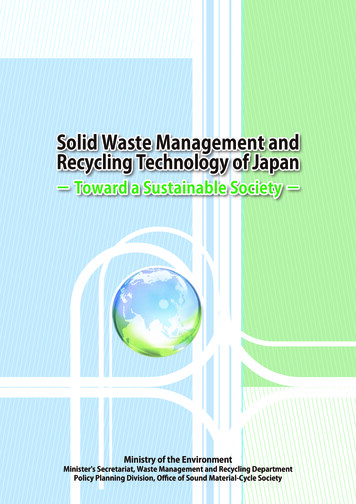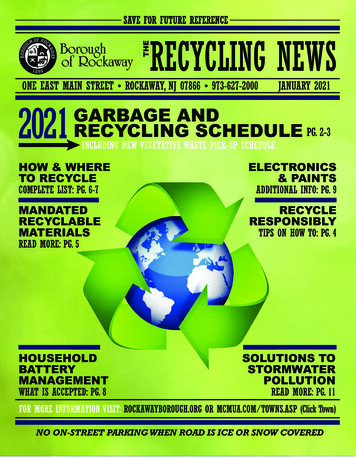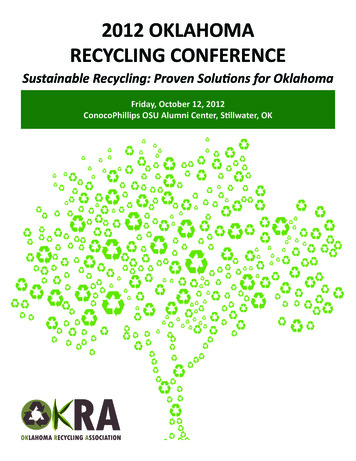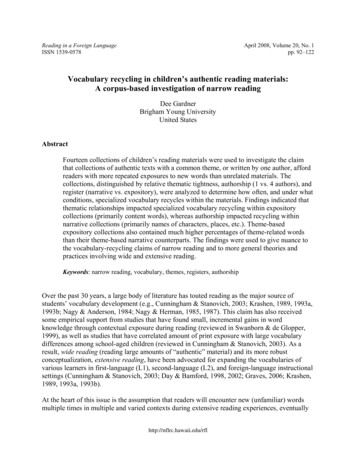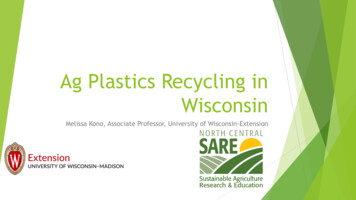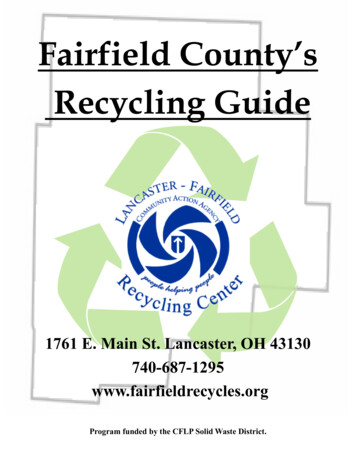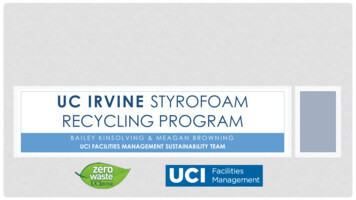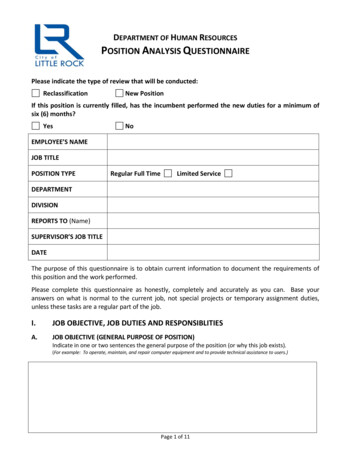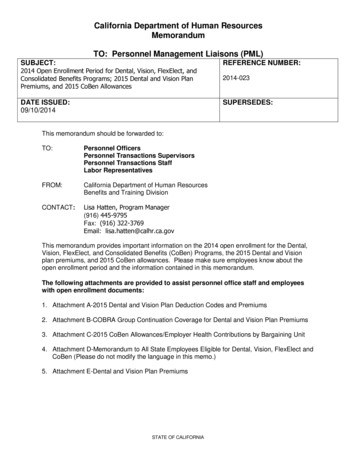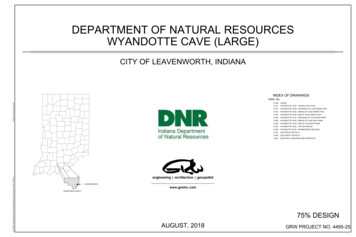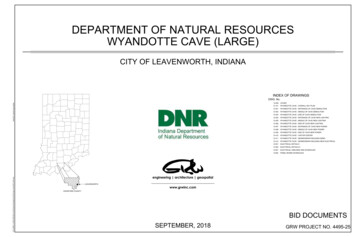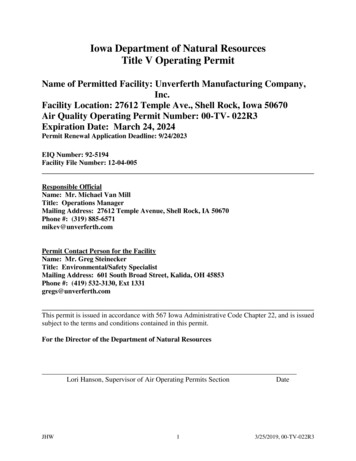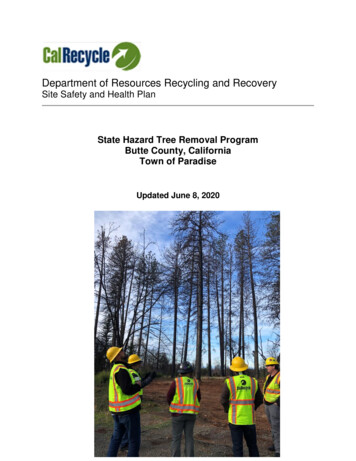
Transcription
Department of Resources Recycling and RecoverySite Safety and Health PlanState Hazard Tree Removal ProgramButte County, CaliforniaTown of ParadiseUpdated June 8, 2020
Table of ContentsAcronyms and Abbreviations . 31. Introduction . 52. Scope of Work . 63. Key Personnel & Responsibilities .104. Logs, Reports, and Recordkeeping .135. Hazard Assessment .146. Safety Inspections .257. Standard Field Activity Procedures .268. Work and Support Areas .2810. Site Monitoring .3011. Emergency Response .3112. Emergency & Hospital Information .3713. Training Requirements .3814. Site-Specific Pre-Job Safety Orientation .3915. Workplace Violence .40Appendix A: Proclamation of State of Emergency .44Appendix B: Tailgate Meeting Format .46Appendix C: Air Monitoring Log .47Appendix D: CalRecycle Incident Report Form (CalRecycle 676) .48Appendix E: COVID-19 Guidance.50Appendix F: COVID-19 DEPLOYMENT CLEARANCE QUESTIONNAIRE .54Approvals .55State Hazard Tree Removal ProgramSite Safety and Health Plan2January 2020
Acronyms and mphNESHAPNIOSHN95 respiratorOperations y (ROW)RCSState Hazard Tree Removal ProgramSite Safety and Health PlanAir-purifying respiratorCalifornia Department of Forestry and Fire ProtectionCalifornia Office of Emergency ServicesCalifornia Occupational Safety and Health AdministrationCalifornia Department of Resources Recycling and RecoveryCalifornia Code of RegulationsCertified Industrial HygienistCarbon monoxideCardiopulmonary resuscitationButte CountyCertified Safety ProfessionalSound level measurement in decibels on A-weighted scaleFinance and Administration Section ChiefHigh-efficiency particulate airHousehold hazardous wasteHeating, ventilation, and air conditioningIncident CommanderImmediately dangerous to life or healthIndustrial hygienistIncident Management TeamMilligrams (substance) per cubic meter (of air)Miles per hourNational Emissions Standards for Hazardous Air PollutantsNational Institute for Occupational Safety and HealthA voluntary-use disposable dust mask that filters 95percent of very small (0.3 microns) particles from airand does not provide protection from oilsTree Removal Operations Plan (TROP)Operations Section ChiefOccupational Safety and Health AdministrationProfessional engineerPermissible exposure limitProfessional geologistPersonal protective equipmentParts per millionPlanning Section ChiefGovernor’s Proclamation of State of EmergencyProperty owned and operated by the Department ofTransportation (CalTrans) for transportation purposes.This may include land, access rights, or both.Respirable crystalline silica (smaller than 10 microns)3January 2020
RoadwaySlashSOFRSSHPTROCTROPTWAUSCGUSEPAUSFSState Hazard Tree Removal ProgramSite Safety and Health PlanThat portion of the highway included between the outsidelines of the sidewalks, or curbs and gutters, or sideditches including also the appertaining structures, andall slopes, ditches, channels, waterways, and otherfeatures necessary for proper drainage and protection.Coarse and fine woody debris generated during loggingoperationsSite Safety and Health OfficerSite-specific Safety and Health PlanTree Removal Operations CenterTree Removal Operations PlanTime weighted averageUnited States Coast GuardUnited States Environmental Protection AgencyUnited States Forest Service4January 2020
1. IntroductionThis Site Safety and Health Plan (SSHP) has been developed for the activitiesperformed by the Department of Resources Recycling and Recovery (CalRecycle) staffassociated with removing hazard trees damaged by the Camp Fire Incident in ButteCounty.The Camp Fire began the morning of November 8, 2018 in Butte County and burned for18 days. It was contained on November 25, 2018. The fire spread very fast due to dryweather, strong winds and heavy fuel loading. It is the most destructive and deadliestwildfire in California history. The fire burned 153,336 acres and destroyed 13,972residences, 528 commercial buildings and 4,293 other buildings. There were 86 civilianfatalities and three firefighter injuries.Acting Governor Gavin Newsom issued an emergency proclamation On November 8,2018 for Butte County because of the Camp Fire. President Trump approvedCalifornia’s Major Disaster Declaration on Monday November 12, 2018. TheProclamation (Appendix A) authorized the state government to “utilize and employ statepersonnel, equipment, and facilities for the performance of any and all activitiesconsistent with the direction of the Office of Emergency Services and the StateEmergency Plan.” This included the removal of the debris and burn ash by CalRecyclefrom damaged parcels in order to protect public health and safety.The emergency proclamation has been extended to include the removal of hazard treeswith the potential to impact roadways, rights-of-way, and public safety within the CampFire burn scar.Butte County and California’s Office of Emergency Services (CalOES) will create aunified command and oversee the removal of hazard trees. CalRecycle will dedicatetheir Incident Management Team (IMT) to the incident and issue contracts toenvironmental contractors to perform work.CalRecycle staff must follow this SSHP to ensure worker safety. This plan is based onknown conditions at the time the plan was written and may be updated as newerinformation is received. This document will be considered a DRAFT until all supportingdocuments have been attached, which include, but are not limited to, the CommunityHealth and Safety Plan, Tree Removal Operations Plan (Operations Plan), and any airmonitoring plans that are completed by CalRecycle or their consultants.State Hazard Tree Removal ProgramSite Safety and Health Plan5January 2020
2. Scope of WorkCalRecycle’s Incident Management Team (IMT) is tasked by CalOES to assist in theremoval of hazard trees with the potential to impact the roadways, rights-of-way, andpublic safety after the Camp Fire.PURPOSEThe purpose of the site work is to remove trees from parcels, roadways, and rights-ofway, in the fire damaged area. To date, the number of trees to be removed has beenestimated at 300,000.CalRecycle is tasked by CalOES to assist the County by providing resources to planand execute tree removal for affected sites. The site work will involve the removal,loading, and transportation of trees and tree-related material (slash) to acceptablebiomass and reuse facilities of CalRecycle’s choosing.The County has identified publicly owned land near roadways, and individual publiclyand privately owned parcels.CalRecycle will assist the County by:1. Removing and disposing of hazard trees identified by a Registered ProfessionalForester;2. Segregating and sorting material and delivering it to biomass facilities;3. Providing traffic control;4. Site contouring, posting signs, and ensuring erosion protection during the project;5. Installing erosion control devices.SITE DESCRIPTION AND BACKGROUNDLocationThe Town of Paradise is located approximately eight miles east of Chico. Elevation is1778 feet above sea level. The Camp Fire started near Pulga Road at Camp CreekRoad in Butte County. The fire burned 153,336 acres in Butte County and directlythrough the Town of Paradise, where most structures were lost. Approximately 13,972residences, 528 commercial structures, and 4293 outbuildings were destroyed by theCamp Fire. Figure 1 shows the burn area. The hazard tree removal area has beendivided into five operational areas representing five separate drainage areas within theCamp Fire burn scar. Each operational area will have its own Public Agency, Public andPrivate Utility Right-of-Way (ROW) Exemption. Figure 2 shows the operational areas.State Hazard Tree Removal ProgramSite Safety and Health Plan6January 2020
Figure 1. Site Location Map of the Camp Incident, Butte CountyState Hazard Tree Removal ProgramSite Safety and Health Plan7January 2020
Figure 2. State Hazard Tree Removal Operational AreasState Hazard Tree Removal ProgramSite Safety and Health Plan8January 2020
Tree Removal Operations CenterA Tree Removal Operations Center (TROC) has been established for managingoperations, answering questions from the public, and storing field supplies. The TROCwill be equipped with office supplies, printers, Internet access and sanitary facilities.Figure 3 shows the location of the Tree Removal Operations Center.The TROC is located at the following address:900 Fortress Street, Suite 200Chico, CA 95973Hours of Operation: 8:00 am – 6:00 pm, Monday - Friday8:00 am – 1:00 pm, SaturdayFigure 3. Tree Removal Operations CenterState Hazard Tree Removal ProgramSite Safety and Health Plan9January 2020
3. Key Personnel & ResponsibilitiesIt is the policy of CalRecycle to provide safe and healthy working conditions foremployees when performing hazard tree removal after a declared state of emergency.All CalRecycle personnel on-site during the remediation and clean-up project are toadhere to standard safety policies. Each employee is responsible for reporting anyinjuries, incidents, and safety infractions to the Site Safety and Health Officer (SOFR) sotreatment can be obtained and/or corrective action taken.KEY PROJECT PERSONNELCalRecycle Contract Administrator/Liaison:Robert Healy, PESenior Waste Management EngineerCalRecycleEngineering Support Branch/Disaster Response Unit(916) 341-6132Project Safety & Health Officer:Vince PaulSenior Safety EngineerCalRecycle/Health and Safety Section(916) 341-6782Site Safety and Health Officers (SOFR):Andy MarinoAssociate Safety EngineerCalRecycle/Health and Safety Section(916) 341-6366Elizabeth GarnerAssociate Safety EngineerCalRecycle/Health and Safety Section(916) 341-6213Operations Section Chiefs (OSC):Bruce Berger, PEWaste Management EngineerCalRecycle/Engineering Support Branch/Disaster Response Unit(916) 341-6729Stephen Eto, PEWaste Management EngineerCalRecycle/Engineering Support Branch/Disaster Response Unit(916) 341-6504Planning Section Chief (PSC):State Hazard Tree Removal ProgramSite Safety and Health PlanPauline TottenPlanning Section ChiefCalRecycle/Engineering Support Branch(916) 341-658310January 2020
Finance and Administration Section Chief (FSC):Jarrod Ramsey-Lewis, PEWaste Management EngineerCalRecycle/Engineering Support Branch/Disaster Response Unit(916) 341-6450KEY SAFETY ROLESOperations Section ChiefThe Operations Section Chief is ultimately responsible for site safety and health and willprovide the materials and maintenance of equipment necessary to enhance andmaintain safe site and work conditions. Responsibilities of the Operations Section Chiefinclude project scheduling, cost updating, and overall project direction. In addition, theOperations Section Chief is responsible for determining the extent and level of inputrequired for technical issues that arise during the project. The Operations Section Chiefwill serve as the primary point of contact. If the Site Safety & Health Officer is notpresent at the site, the Operations Section Chief or their designee will assume all safetyand health responsibility of the site.Project Safety & Health OfficerThe Project Safety and Health Officer will be responsible for review and approval ofCalRecycle’s Site Safety and Health Plan (SSHP) and will assist and advise the SiteSafety and Health Officer (SOFR). He/she has the authority to stop unsafe operations,recommend the removal of unqualified personnel from the work area, and approvechanges to CalRecycle’s SSHP.The Project Safety and Health Officer will have responsibility for integrating all aspectsof CalRecycle’s SSHP into this hazard tree removal project. His/her duties includeadvising the SOFR on all related Health and Safety aspects, reviewing any Site SpecificSafety Plans for compliance and completeness, and establishing and monitoring allrelated Health and Safety procedures through site safety audits.The Project Safety and Health Officer will coordinate with the SOFR to ensure overallcompliance with the SSHP. The SOFR will provide ongoing communication with ProjectSafety and Health Officer on issues related to site operations.Site Safety and Health Officer (SOFR)The SOFR is responsible for overseeing work areas and identifying conditions that maypose a hazard to personnel or the public. The SOFR will convey any concerns orchanges before work commences for the day through daily tailgate meetings. TheSOFR is required to conduct regular safety inspections, and to implement and enforcethe project safety program and procedures. The SOFR will work closely with theOperations Section Chief to ensure that all site personnel review and comply with theterms of the CalRecycle’s SSHP. The SOFR performs duties such as verifying thatpersonnel have appropriate training, coordinating emergency medical care, conductingState Hazard Tree Removal ProgramSite Safety and Health Plan11January 2020
a daily site safety inspection (if required), and inspecting safety and health equipment.In addition, the SOFR is responsible for maintaining safety equipment, posting airmonitoring results (if required), providing site orientation safety training for all personnelactively involved in site work (if required), and other site safety documentation.The SOFR takes the following action(s) when appropriate: Orders the immediate shutdown of site activities in the case of a medicalemergency, unsafe practice or if the SOFR deems it necessary.Ensures protective clothing and equipment are properly stored, used, andmaintained.Ensures that the environmental and personnel monitoring operations are ongoingand in accordance with technical specifications and required procedures.Restricts visitors from areas of potential exposure to harmful substances.The SOFR will maintain the safety log at the site. This log will include any daily safetymeeting topics, training provided, site monitoring data, first aid administered, and allhealth and safety incidents. The SOFR will investigate all accidents, prepare anaccident investigation report, and forward it to the Operations Section Chief and theIncident Commander.Subcontractor Management and PersonnelSubcontractor management is responsible for the compliance of their personnel with theSite Safety and Health Plan (SSHP). Since subcontractors are hired for their specificexpertise, they must assume primary responsibility for the health and safety of theirpersonnel. The subcontractor’s Field Supervisor will also be responsible for performingregular safety inspections of their operations. The subcontractor must participate inCalRecycle’s safety meetings before commencing operations.Subcontractors must also: Comply with all applicable California Occupational Safety and HealthAdministration (Cal/OSHA) regulations as defined in California Code ofRegulations, Title 8Perform all work in accordance with this SSHPConduct daily tailgate safety meetings and make the minutes available to theSOFR or the Operations Section ChiefState Hazard Tree Removal ProgramSite Safety and Health Plan12January 2020
4. Logs, Reports, and RecordkeepingThe following logs, reports, and records will be developed and maintained by the SOFR: Tailgate Safety Meetings (Appendix B)Site-Specific Health and Safety PlanInjury and Illness Prevention Program RecordsEmergency Action PlanState Hazard Tree Removal ProgramSite Safety and Health Plan13January 2020
5. Hazard AssessmentThis section addresses the potential hazards identified with hazard tree removal andcleanup of the site, which include but are not limited to chemical, biological, physical,and environmental hazards. Hazard characterization and selection of worker protectionmethods for this project have been determined from previous cleanup jobs as well asthe site’s history.HAZARD ASSESSMENTTo provide protection for personnel on-site, the following table summarizes predetermined high-risk hazards. The contaminants identified at the site, the work tasksperformed, and the environmental conditions of the site were considered in making thedetermination.SUMMARY OF SITE HIGH RISK HAZARDSHAZARDThermal stressTYPE OFEXPOSUREPhysicalCONTROL MEASURESHeat Stress Drink a quart of water per hour. Take cooling rest breaks in the shade. Avoid physical activity during the hottest part of the day ifpossible. Wear cool and breathable clothing. Apply sunscreen. Wear a hat, sun visor, or some form of personal shadeprotection.Cold Stress Ensure clothing and boots have adequate insulation. Avoid working alone. Getting wet from rain or sweat can worsen heat loss in coldweather. Wear rain protective clothing and rubber boots in rain and coldweather. If wet, change into dry clothing when possible.State Hazard Tree Removal ProgramSite Safety and Health Plan14January 2020
HAZARDTYPE OFEXPOSURECONTROL MEASURES Vehicles/HeavyEquipmentPhysical UnstableStructuresPhysical Slips, Trips,and lationAirborneContaminants(e.g., carbonmonoxide)Chemical:InhalationState Hazard Tree Removal ProgramSite Safety and Health PlanLimit personnel around heavy equipment especially when thereare moving parts.Maintain situational awareness of all equipment working on thesite.Remain as far away from equipment as the job permits. If youmust move near equipment, establish eye contact with theoperator before proceeding.Never stand underneath an excavator or cherry picker bucketor anywhere else where there may be falling debris.Use cones and spotters to assist with safety around heavyequipment.Communicate with machine operators frequently.Listen for backup alarms.Wear high visibility safety vest around vehicles and heavyequipment.Do not stand or work around standing structures or treesdamaged by fire.Allow heavy equipment to knock down standing structuresbefore working in an area.Leave the area immediately if a structure shifts or unusualno
HVAC Heating, ventilation, and air conditioning . Andy Marino Associate Safety Engineer CalRecycle/Health and Safety Section (916) 341-6366 Elizabeth Garner Associate Safety Engineer . (FSC): Jarrod Ramsey-Lewis, PE Waste Management Engineer CalRecycle/Engineering Support Bran
